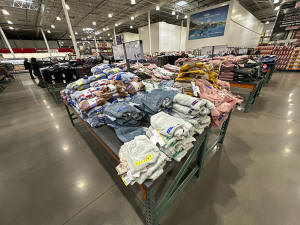Inflation cooled again even as some tariffs took effect. But economists
don't expect that to last
[May 14, 2025] By
CHRISTOPHER RUGABER
WASHINGTON (AP) — Inflation cooled for the third straight month in April
even after some of President Donald Trump’s tariffs took effect, though
economists and many business owners expect inflation will climb by this
summer.
Consumer prices rose 2.3% in April from a year ago, the Labor Department
said Tuesday, down from 2.4% in March and the smallest increase in more
than four years. On a monthly basis, prices rose modestly, increasing
0.2% from March to April after falling 0.1% the previous month, the
first drop in five years.
Grocery prices dipped 0.4% from March to April in what will come as a
relief to many people stretching family budgets for the basics. It was
the biggest decline in food costs at home since September 2020, the
government said. Egg prices fell sharply, declining 12.7%, the most in
41 years. Yet they are still 49% higher than a year ago.
Overall, the report suggests tariffs haven't yet impacted prices for
many items. Economists say the impact will more likely be seen by June
or July. The 10% tariff on all goods that took effect April 5 could take
two to three months to feed into the inflation data. And many companies
built stockpiles of products earlier this year, enabling them to delay
price hikes in hopes that the trade war will cool.
The cost of clothing, which is mostly imported, declined 0.2% from March
to April, Tuesday's report said. New car prices were unchanged. And
grocery prices fell despite fears that tariffs on some goods from Mexico
would boost food costs.

“It's early days for tariff effects,” said Laura Rosner-Warburton,
co-founder of MacroPolicy Perspectives and formerly an economist at the
Federal Reserve's New York branch. “More will come in May, June, and
July. There are plenty of price increases already scheduled and on the
way.”
And there were some early signs that the duties are having an impact.
Computer prices rose 0.3% from March to April, a category that is
heavily imported from China and usually sees mild price declines.
Sporting goods and toys, where many products are imported, also saw
increases. And a category that includes baby strollers and car seats
also got more expensive.
Still, excluding the volatile food and energy categories, core prices
were also muted, rising 2.8% in April compared with a year ago, the same
as in March. On a monthly basis, they increased a mild 0.2%. Economists
watch core prices because they typically provide a better read on where
inflation is headed.
Rosner-Warburton noted that some prices fell as business weakened,
particularly in travel. Air fares and hotel prices dropped noticeably
last month, contributing to lower inflation, but that may have been
driven by a decline in foreign visitors to the U.S.
Some companies have raised prices and others have said they plan to do
so as a result of the duties. Mattel Inc., the maker of Barbie dolls and
Hot Wheels cars, said earlier this month it would have to raise prices
on some products. The company makes 40% of its products in China.
Tool maker Stanley Black & Decker said it raised prices in April and
plans to do so again in the July-September quarter because of higher
tariffs. And executives at Procter & Gamble, the consumer products giant
that makes household name brands such as Crest toothpaste, Tide
detergent, and Charmin toilet paper, said last month it will likely have
to pass on higher prices to consumers as soon as July.
Only some early tariffs imposed by Trump were in effect in April,
including 25% duties on steel and aluminum and 25% on some imports from
Canada and Mexico. Trump's initial 20% import taxes on goods from China
were also in place. The steel and aluminum duties will take time to feed
through into consumer products, such as cars, and may not affect retail
prices for months.

[to top of second column] |

Children's clothing sits stacked on a table for shoppers in a Costco
warehouse Thursday, Jan. 23, 2025, in Sheridan, Colo. (AP
Photo/David Zalubowski, File)
 Trump's huge 145% import taxes on
Chinese goods were reduced to 30% in a deal announced Monday, with
some of the higher tariffs on pause for 90 days. Retailers and
importers had largely stopped shipping shoes, clothes, toys, and
other items when the duties were so high, but many will now resume
importing from China, which should reduce the chances of empty
shelves this fall.
Yet the additional 30% duties, on top of other import taxes, will
likely affect prices. The Footwear Distributors and Retailers of
America, a trade group, says children's shoes from China will now
pay a nearly 100% tariff, because the latest duties are on top of
previous import taxes.
Matt Priest, president and CEO of the FDRA, said that the cost of
shipping goods from China will likely rise as many companies
scramble to get orders to the U.S. during the 90-day window.
“We're not out of the inflationary cost woods yet,” he said.
And economists say average tariffs are now at about 18%, roughly six
times higher than before Trump took office and the highest in about
90 years.
Consumer prices cooled noticeably in February and March, prompting
Trump to claim repeatedly on social media that there is “NO
INFLATION." Inflation has fallen to nearly the 2% target set by the
Federal Reserve, the agency charged with fighting higher prices.
The Fed would have likely been gearing up to restart interest rate
cuts in the absence of tariffs because inflation is down. It reduced
its benchmark rate three times last year. However, it has since
frozen rates while it awaits further evidence of how the tariffs —
and other policy changes, such as immigration restrictions and
potential tax cuts — affect the economy.
The smaller import taxes on Chinese goods will limit the damage to
the U.S. economy, but combined with all the other tariffs,
economists forecast they will still slow growth this year and worsen
inflation.

The Yale Budget Lab, for example, estimates the tariffs will lift
prices 1.7% and cost the average household about $2,800 this year.
“This is still a very, very substantial tariff hike, but it will
take awhile” to show up in the inflation data, Alan Detmeister, an
economist at UBS, said.
Many small businesses are relieved that the U.S. has cut its tariffs
on goods from China but say they still aren’t sure what their costs
will be for the remainder of this year, or whether they can avoid
raising prices themselves.
Rick Woldenberg, CEO of Learning Resources, an educational toy
company, said that the 145% tariffs would have pushed his tariff
bill to $100.2 million from $2.3 million last year.
He paused shipments and production but is now strategizing how to
work with the lower tariffs. He has 13 containers stored in
warehouses in Los Angeles, which allows importers to defer duty
payments for up to five years. And he may bring $11 million of goods
from China and pay the 30% tariffs, but he’s not sure how to price
them.
“We just don’t know what our costs are,” he said. “We do not know
what our tariff costs are. We do not know what our freight costs
are.”
__
AP Retail Writer Anne D'Innocenzio contributed to this report from
New York.
All contents © copyright 2025 Associated Press. All rights reserved |